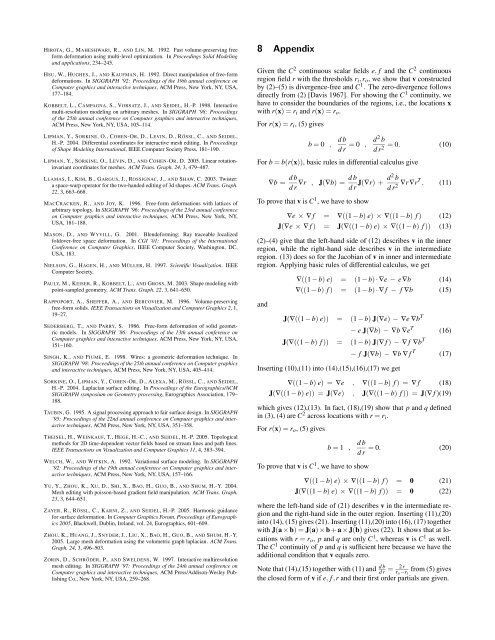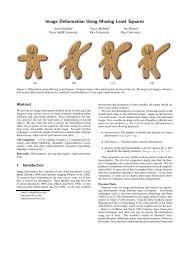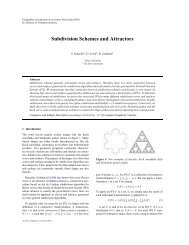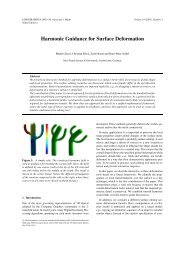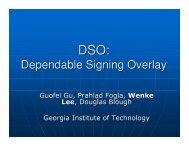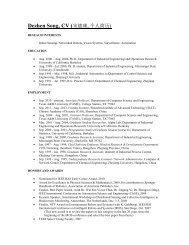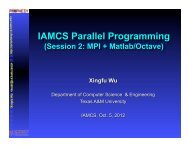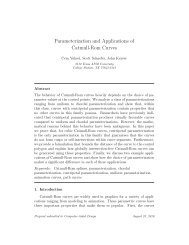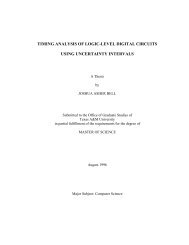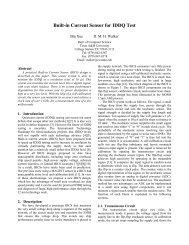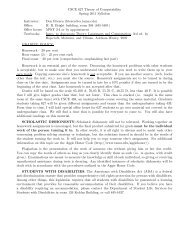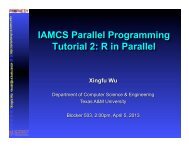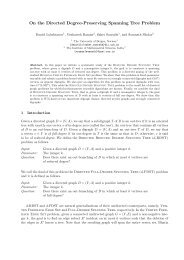Vector Field Based Shape Deformations
Vector Field Based Shape Deformations
Vector Field Based Shape Deformations
You also want an ePaper? Increase the reach of your titles
YUMPU automatically turns print PDFs into web optimized ePapers that Google loves.
HIROTA, G., MAHESHWARI, R., AND LIN, M. 1992. Fast volume-preserving freeform deformation using multi-level optimization. In Proceedings Solid Modelingand applications, 234–245.HSU, W., HUGHES, J., AND KAUFMAN, H. 1992. Direct manipulation of free-formdeformations. In SIGGRAPH ’92: Proceedings of the 19th annual conference onComputer graphics and interactive techniques, ACM Press, New York, NY, USA,177–184.KOBBELT, L., CAMPAGNA, S., VORSATZ, J., AND SEIDEL, H.-P. 1998. Interactivemulti-resolution modeling on arbitrary meshes. In SIGGRAPH ’98: Proceedingsof the 25th annual conference on Computer graphics and interactive techniques,ACM Press, New York, NY, USA, 105–114.LIPMAN, Y., SORKINE, O., COHEN-OR, D., LEVIN, D., RÖSSL, C., AND SEIDEL,H.-P. 2004. Differential coordinates for interactive mesh editing. In Proceedingsof <strong>Shape</strong> Modeling International, IEEE Computer Society Press, 181–190.LIPMAN, Y., SORKINE, O., LEVIN, D., AND COHEN-OR, D. 2005. Linear rotationinvariantcoordinates for meshes. ACM Trans. Graph. 24, 3, 479–487.LLAMAS, I., KIM, B., GARGUS, J., ROSSIGNAC, J., AND SHAW, C. 2003. Twister:a space-warp operator for the two-handed editing of 3d shapes. ACM Trans. Graph.22, 3, 663–668.MACCRACKEN, R., AND JOY, K. 1996. Free-form deformations with lattices ofarbitrary topology. In SIGGRAPH ’96: Proceedings of the 23rd annual conferenceon Computer graphics and interactive techniques, ACM Press, New York, NY,USA, 181–188.MASON, D., AND WYVILL, G. 2001. Blendeforming: Ray traceable localizedfoldover-free space deformation. In CGI ’01: Proceedings of the InternationalConference on Computer Graphics, IEEE Computer Society, Washington, DC,USA, 183.NIELSON, G., HAGEN, H., AND MÜLLER, H. 1997. Scientific Visualization. IEEEComputer Society.PAULY, M., KEISER, R., KOBBELT, L., AND GROSS, M. 2003. <strong>Shape</strong> modeling withpoint-sampled geometry. ACM Trans. Graph. 22, 3, 641–650.RAPPOPORT, A., SHEFFER, A., AND BERCOVIER, M. 1996. Volume-preservingfree-form solids. IEEE Transactions on Visualization and Computer Graphics 2, 1,19–27.SEDERBERG, T., AND PARRY, S. 1986. Free-form deformation of solid geometricmodels. In SIGGRAPH ’86: Proceedings of the 13th annual conference onComputer graphics and interactive techniques, ACM Press, New York, NY, USA,151–160.SINGH, K., AND FIUME, E. 1998. Wires: a geometric deformation technique. InSIGGRAPH ’98: Proceedings of the 25th annual conference on Computer graphicsand interactive techniques, ACM Press, New York, NY, USA, 405–414.SORKINE, O., LIPMAN, Y., COHEN-OR, D., ALEXA, M., RÖSSL, C., AND SEIDEL,H.-P. 2004. Laplacian surface editing. In Proceedings of the Eurographics/ACMSIGGRAPH symposium on Geometry processing, Eurographics Association, 179–188.TAUBIN, G. 1995. A signal processing approach to fair surface design. In SIGGRAPH’95: Proceedings of the 22nd annual conference on Computer graphics and interactivetechniques, ACM Press, New York, NY, USA, 351–358.THEISEL, H., WEINKAUF, T., HEGE, H.-C., AND SEIDEL, H.-P. 2005. Topologicalmethods for 2D time-dependent vector fields based on stream lines and path lines.IEEE Transactions on Visualization and Computer Graphics 11, 4, 383–394.WELCH, W., AND WITKIN, A. 1992. Variational surface modeling. In SIGGRAPH’92: Proceedings of the 19th annual conference on Computer graphics and interactivetechniques, ACM Press, New York, NY, USA, 157–166.YU, Y., ZHOU, K., XU, D., SHI, X., BAO, H., GUO, B., AND SHUM, H.-Y. 2004.Mesh editing with poisson-based gradient field manipulation. ACM Trans. Graph.23, 3, 644–651.ZAYER, R., RÖSSL, C., KARNI, Z., AND SEIDEL, H.-P. 2005. Harmonic guidancefor surface deformation. In Computer Graphics Forum, Proceedings of Eurographics2005, Blackwell, Dublin, Ireland, vol. 24, Eurographics, 601–609.ZHOU, K., HUANG, J., SNYDER, J., LIU, X., BAO, H., GUO, B., AND SHUM, H.-Y.2005. Large mesh deformation using the volumetric graph laplacian. ACM Trans.Graph. 24, 3, 496–503.ZORIN, D., SCHRÖDER, P., AND SWELDENS, W. 1997. Interactive multiresolutionmesh editing. In SIGGRAPH ’97: Proceedings of the 24th annual conference onComputer graphics and interactive techniques, ACM Press/Addison-Wesley PublishingCo., New York, NY, USA, 259–268.8 AppendixGiven the C 2 continuous scalar fields e, f and the C 2 continuousregion field r with the thresholds r i ,r o , we show that v constructedby (2)–(5) is divergence-free and C 1 . The zero-divergence followsdirectly from (2) [Davis 1967]. For showing the C 1 continuity, wehave to consider the boundaries of the regions, i.e., the locations xwith r(x) = r i and r(x) = r o .For r(x) = r i , (5) givesb = 0 ,d bd r = 0 ,d 2 b= 0. (10)d r2 For b = b(r(x)), basic rules in differential calculus give∇b = d bd r ∇r ,To prove that v is C 1 , we have to showJ(∇b) = d bd r J(∇r) + d2 bd r 2 ∇r ∇rT . (11)∇e × ∇ f = ∇((1 − b) e) × ∇((1 − b) f ) (12)J(∇e × ∇ f ) = J(∇((1 − b) e) × ∇((1 − b) f )) (13)(2)–(4) give that the left-hand side of (12) describes v in the innerregion, while the right-hand side describes v in the intermediateregion. (13) does so for the Jacobian of v in inner and intermediateregion. Applying basic rules of differential calculus, we getand∇((1 − b) e) = (1 − b) · ∇e − e∇b (14)∇((1 − b) f ) = (1 − b) · ∇ f − f ∇b (15)J(∇((1 − b) e)) = (1 − b) J(∇e) − ∇e ∇b T− e J(∇b) − ∇b ∇e T (16)J(∇((1 − b) f )) = (1 − b) J(∇ f ) − ∇ f ∇b TInserting (10),(11) into (14),(15),(16),(17) we get− f J(∇b) − ∇b ∇ f T (17)∇((1 − b) e) = ∇e , ∇((1 − b) f ) = ∇ f (18)J(∇((1 − b) e)) = J(∇e) , J(∇((1 − b) f )) = J(∇ f )(19)which gives (12),(13). In fact, (18),(19) show that p and q definedin (3), (4) are C 2 across locations with r = r i .For r(x) = r o , (5) givesb = 1 ,To prove that v is C 1 , we have to showd b= 0. (20)d r∇((1 − b) e) × ∇((1 − b) f ) = 0 (21)J(∇((1 − b) e) × ∇((1 − b) f )) = 0 (22)where the left-hand side of (21) describes v in the intermediate regionand the right-hand side in the outer region. Inserting (11),(20)into (14), (15) gives (21). Inserting (11),(20) into (16), (17) togetherwith J(a × b) = J(a) × b + a × J(b) gives (22). It shows that at locationswith r = r o , p and q are only C 1 , whereas v is C 1 as well.The C 1 continuity of p and q is sufficient here because we have theadditional condition that v equals zero.Note that (14),(15) together with (11) and d d br = r 2ro −r ifrom (5) givesthe closed form of v if e, f ,r and their first order partials are given.


